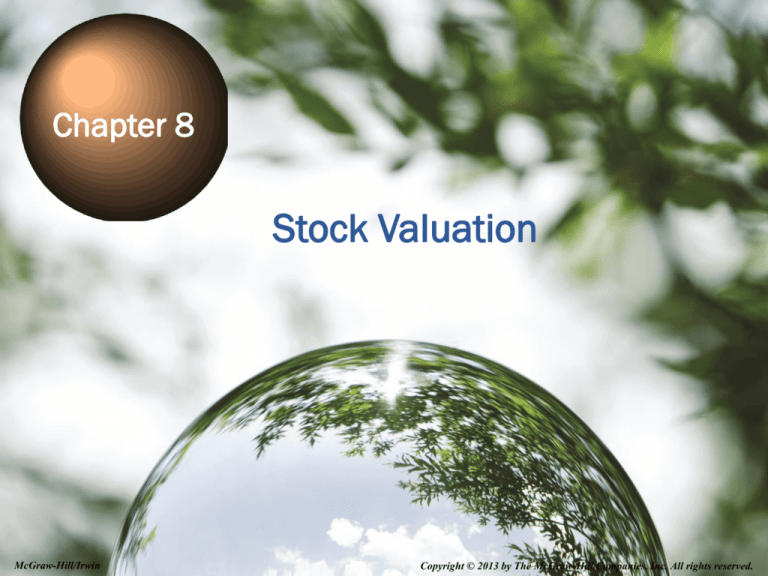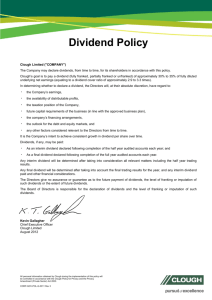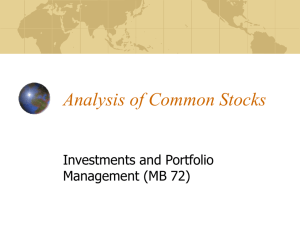
Chapter 8
Stock Valuation
8-1
McGraw-Hill/Irwin
Copyright © 2013 by The McGraw-Hill Companies, Inc. All rights reserved.
Chapter Outline
•
•
•
•
•
8-2
Bond and Stock Differences
Common Stock Valuation
Features of Common Stock
Features of Preferred Stock
The Stock Markets
Bonds and Stocks: Similarities
• Both provide long-term funding for the
organization
• Both are future funds that an investor
must consider
• Both have future periodic payments
• Both can be purchased in a marketplace
at a price “today”
8-3
Bonds and Stocks: Differences
• From the firm’s perspective: a bond is a
long-term debt and stock is equity
• From the firm’s perspective: a bond gets
paid off at the maturity date; stock
continues indefinitely.
• We will discuss the mix of bonds (debt) and
stock (equity) in a future chapter entitled
capital structure
8-4
Bonds and Stocks: Differences
• A bond has coupon payments and a
lump-sum payment; stock has dividend
payments forever
• Coupon payments are fixed; stock
dividends change or “grow” over time
8-5
A visual representation of a
bond with a coupon payment (C)
and a maturity value (M)
8-6
1
2
3
4
5
$C1
$C2
$C3
$C4
$C5
$M
A visual representation of a
share of common stock with
dividends (D) forever
8-7
1
2
3
4
$D1
$D2
$D3
$D4
5
∞
$D5 $D∞
Comparison Valuations
0
1
P0
C
0
P0
8-8
Bond
2
3
C
C
M
Common Stock
1
2
3
D1
D2
D3
D∞
Notice these differences:
• The “C’s” are constant and equal
• The bond ends (year 5 here)
• There is a lump sum at the end
8-9
1
2
3
4
5
$C1
$C2
$C3
$C4
$C5
$M
Notice these differences:
• The dividends are different
• The stock never ends
• There is no lump sum
8-10
1
2
3
4
5
$D1
$D2
$D3
$D4
$D5
∞
$D∞
Our Task:
To value a share of
Common Stock
8-11
8-12
Bring
All
Expected
Future
Earnings
Into
Present
Value
Terms
Just remember:
8-13
Cash Flows for Stockholders
If you buy a share of stock,
you can receive cash in two
ways:
1. The company pays
dividends
8-14
2. You sell your shares,
either to another
investor in the market
or back to the
company
One-Period Example
Receiving one future dividend
and one future selling price of
a share of common stock
8-15
One-Period Example
Suppose you are thinking of
purchasing the stock of Moore Oil, Inc.
You expect it to pay a $2 dividend in
one year, and you believe that you can
sell the stock for $14 at that time.
If you require a return of 20% on
investments of this risk, what is the
maximum you would be willing to pay?
8-16
Visually this would look like:
R = 20%
1
D1 = $2
P1 = $14
8-17
Compute the Present Value
R = 20%
$1.67
$11.67
PV =$13.34
8-18
1
D1 = $2
P1 = $14
TI BA II Plus
-13.34
1 year = N
20% = Discount rate
$2 = Payment (PMT)
$14 = FV
1st
2nd
8-19
PV = ?
1 year = N
HP
20% = Discount rate
$2 = Payment (PMT)
PV = ?
$14 = FV
-13.34
8-20
12-C
Two Period Example
Now, what if you decide to hold the
stock for two years? In addition to the
dividend in one year, you expect a
dividend of $2.10 in two years and a
stock price of $14.70 at the end of
year. Now how much would you be
willing to pay?
8-21
Visually this would look like:
R = 20%
1
D1 = $2
8-22
2
D2 = $ 2.10
P2 = $14.70
Compute the Present Value
R = 20%
$1.67
$1.46
$ 10.21
$ 13.34 = P0
8-23
1
D1 = $2
2
D2 = $ 2.10
P2 = $14.70
What is the Observed Pattern?
We value a share of stock by
bring back all expected future
dividends into present value
terms
8-24
Future Dividends
So the key is to determine
the future dividends
when given the growth
rate of those dividends,
whether the growth is
zero, constant, or unusual
first and then levels off to
a constant growth rate.
8-25
So how do you compute the
future dividends?
Three scenarios:
1. A constant dividend (zero growth)
2. The dividends change by a constant
growth rate
3. We have some unusual growth periods
and then level off to a constant growth
rate
8-26
1. Constant Dividend –
Zero Growth
• The firm will pay a constant
dividend forever
• This is like preferred stock
• The price is computed using the
perpetuity formula:
P0 = D / R
8-27
So how do you compute the
future dividends?
Three scenarios:
1. A constant dividend (zero growth)
2. The dividends change by a constant
growth rate
3. We have some unusual growth periods
and then level off to a constant growth
rate
8-28
2. Constant Growth Rate of
Dividends
Dividends are expected to grow at a constant
percent per period.
P0 = D1 /(1+R) + D2 /(1+R)2 + D3 /(1+R)3 + …
P0 = D0(1+g)/(1+R) + D0(1+g)2/(1+R)2 +
D0(1+g)3/(1+R)3 + …
8-29
2. Constant Growth Rate of
Dividends
With a little algebra this reduces to:
D 0 (1 g)
D1
P0
R -g
R -g
8-30
2. Constant Growth Rate of
Dividends
Student caution:
D0 (1 g)
D1
P0
R -g
R -g
8-31
A. What happens if g > R?
B. What happens if g = R?
Dividend Growth Model
(DGM) Assumptions
To use the Dividend Growth Model (aka the
Gordon Model), you must meet all three
requirements:
1. The growth of all future dividends must be
constant,
2. The growth rate must be smaller than the
discount rate ( g < R), and
3. The growth rate must not be equal to the
discount rate (g ≠ R)
8-32
DGM – Example 1
Suppose Big D, Inc., just paid a
dividend (D0) of $0.50 per share. It is
expected to increase its dividend by
2% per year.
If the market requires a return of
15% on assets of this risk, how much
should the stock be selling for?
8-33
DGM – Example 1 Solution
D0 (1 g)
D1
P0
R -g
R -g
P0 =
P0 =
8-34
.50 ( 1 + .02)
.15 - .02
.51
.13
= $3.92
DGM – Example 2
Suppose Moore Oil Inc., is
expected to pay a $2 dividend in
one year. If the dividend is
expected to grow at 5% per year
and the required return is 20%,
what is the price?
8-35
DGM – Example 2 Solution
D0 (1 g)
D1
P0
R -g
R -g
P0 =
P0 =
8-36
2.00
.20 - .05
2.00
.15
= $13.34
So how do you compute the
future dividends?
Three scenarios:
1.A constant dividend (zero growth)
2.The dividends change by a constant
growth rate
3.We have some unusual growth periods
and then level off to a constant growth
rate
8-37
Using the DGM to Find R
Start with the DGM and then algebraically
rearrange the equation to solve for R:
D 0 (1 g)
D1
P0
R -g
R -g
D 0 (1 g)
D1
R
g
g
P0
P0
8-38
Finding the Required Return Example
Suppose a firm’s stock is selling for $10.50. It just
paid a $1 dividend, and dividends are expected to
grow at 5% per year.
What is the required return?
R = [1(1.05)/10.50] + .05 = 15%
What is the dividend yield?
1(1.05) / 10.50 = 10%
What is the capital gains yield?
g =5%
8-39
Stock Valuation Alternative
But my company
doesn’t pay
dividends!
How can I value the
stock?
8-40
Valuation Using Multiples
We can use the PE ratio and/or
the price-sales ratio:
Pt = Benchmark PE ratio X EPSt
Pt = Benchmark price-sales ratio X
Sales per sharet
8-41
Stock Valuation Summary
8-42
Features of Common Stock
• Voting Rights
• Proxy voting
• Classes of stock
8-43
Dividend Characteristics
• Dividends are not a liability of the firm until a
dividend has been declared by the Board
• Consequently, a firm cannot go bankrupt for
not declaring dividends
8-44
Dividend Characteristics
Dividends and Taxes
• Dividend payments are not considered
a business expense; therefore, they are not
tax deductible
• The taxation of dividends received by
individuals depends on the holding period
• Dividends received by corporations have a
minimum 70% exclusion from taxable
income
8-45
Stock Market, Dealers vs. Brokers
Dealer: trades with inventory for bid and
ask prices
Broker: matches buyers and sellers for a
fee
8-46
Stock Market
• New York Stock Exchange (NYSE)
• Largest stock market
in the world
• License holders (1,366)
• Commission brokers
• Specialists
• Floor brokers
• Floor traders
• Operations
• Floor activity
8-47
NASDAQ
• Not a physical exchange – it is a computerbased quotation system
• Multiple market makers
• Electronic Communications Networks
8-48
NASDAQ
• Three levels of information:
• Level 1 – median quotes, registered
representatives
• Level 2 – view quotes, brokers & dealers
• Level 3 – view and update quotes, dealers
only
• A large portion of technology stocks are
bought and sold each day on NASDAQ
8-49
Reading Stock Quotes
8-50
Comprehensive Problem
XYZ stock currently sells for $50 per share. The next
expected annual dividend is $2, and the growth rate is
6%. What is the expected rate of return on this stock?
If the required rate of return on this stock were 12%,
what would the stock price be, and what would the
dividend yield be?
8-51
Formulas
Value of a
Perpetuity:
P0 = D
R
Value of a Share of Common Stock using the DGM:
D 0 (1 g)
D1
P0
R -g
R -g
8-52
D 0 (1 g)
D1
R
g
g
P0
P0
Formulas
Value of a Share of Common Stock
using Multiples
Pt = Benchmark PE ratio X EPSt
Pt = Benchmark price-sales ratio X
Sales per sharet
8-53
What are the most important
topics of this chapter?
1. A stock’s value is the present value of
all expected future earnings.
2. Computing the future dividends of a
stock is the key to understanding its
value
3. Issuing stock provides the firm longterm funding
8-54
What are the most
important topics of this
chapter?
4. The Dividend Growth Model (DGM)
provides us help with infinite
dividend streams
5. Stocks are bought and sold each
business day with reporting via stock
quotes
8-55









